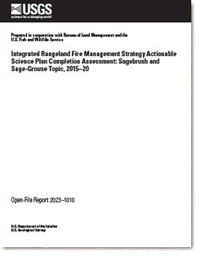Integrated Rangeland Fire Management Strategy Actionable Science Plan Completion Assessment: Sagebrush and Sage-Grouse Topic, 2015–20
Links
- Document: Report (5.7 MB pdf) , XML
- Related Works:
- OFR 2023-1003 — Integrated rangeland fire management strategy actionable science plan completion assessment—Invasives topic, 2015–20
- OFR 2023-1004 — Integrated rangeland fire management strategy actionable science plan completion assessment—Restoration topic, 2015–20
- OFR 2023-1009 — Integrated rangeland fire management strategy actionable science plan completion assessment—Fire topic, 2015–20
- OFR 2023-1035 — Integrated rangeland fire management strategy actionable science plan completion assessment— Climate and weather topic, 2015–20
- Download citation as: RIS | Dublin Core
Abstract
Loss and degradation of sagebrush rangelands due to an accelerated invasive annual grass-wildfire cycle and other stressors are significant management, conservation, and economic issues in the western United States. These sagebrush rangelands comprise a unique biome spanning 11 states, support over 350 wildlife species, and provide important ecosystem services that include stabilizing the economies of western communities. Impacts to sagebrush ecosystem processes over large areas due to the annual grass-wildfire cycle necessitated the development of a coordinated, science-based strategy for improving efforts to achieve long-term protection, conservation, and restoration of sagebrush rangelands, which was framed in 2015 under the Integrated Rangeland Fire Management Strategy (IRFMS). Central to this effort was the development of an Actionable Science Plan (Plan) that identified 37 priority science needs (Needs) for informing the actions proposed under the 5 topics (Fire, Invasives, Restoration, Sagebrush and Sage-Grouse, Climate and Weather) that were part of the collective focus of the IRFMS. Notable keys to this effort were identification of the Needs co-produced by managers and researchers, and a focus on resulting science being “actionable.”
Substantial investments aimed at fulfilling the Needs identified in the Plan have been made since its release in 2016. While the state of the science has advanced considerably, the extent to which knowledge gaps remain relative to identified Needs is relatively unknown. Moreover, new Needs have likely emerged since the original strategy as results from actionable science reveal new questions and possible (yet untested) solutions. A quantifiable assessment of the progress made on the original science Needs can identify unresolved gaps and new information that can help inform prioritization of future research efforts.
This report details a systematic literature review that evaluated how well peer-reviewed journal articles and formal technical reports published between January 1, 2015, and December 31, 2020, addressed nine needs (hereinafter, “Needs”) identified under the Sagebrush and Sage-Grouse topic in the Plan. The topic outlined research Needs broadly focused on understanding sagebrush rangelands and population dynamics important for the conservation and management of sage-grouse and other sagebrush-reliant wildlife species. We established the level of progress towards addressing each Need following a standardized set of criteria, and developed summaries detailing how research objectives nested within Needs identified in the Plan (‘Next Steps’) were either addressed well, partially addressed or remain outstanding (in other words, addressed poorly) in the literature through 2020. Our searches resulted in the inclusion of 333 science products that at least partially addressed a Need identified in the Sagebrush and Sage-Grouse topic. The Needs that were well and partially addressed included:
- development of biome-wide mapping techniques that provide regularly updated grassland and shrubland vegetation layers (Need 4);
- generation of spatially explicit greater sage-grouse habitat suitability and population models (Need 5);
- identification of greater sage-grouse seasonal habitats (Need 6);
- identification of thresholds for the extent of threats, especially conifer expansion, above which greater sage-grouse and other sagebrush-obligate species cannot persist (Need 8); and
- studies of sagebrush community dynamics as those relate to management and restoration of sagebrush rangelands (Need 9).
Needs addressed poorly included:
- investigations of factors conducive and restrictive to greater sage-grouse movement patterns and population connectivity (Need 1);
- investigations of livestock and other large ungulate (for example, feral horse) grazing effects on greater sage-grouse populations and habitats (Need 2);
- identification of thresholds of disturbance (especially renewable energy developments) below which greater sage-grouse and other sagebrush reliant species are not impacted (Need 3); and
- studies of habitat relationships for sagebrush-reliant species other than greater sage-grouse, songbirds, and small mammals (Need 7).
The information provided in this assessment will assist updating the Plan along with other science strategies.
Suggested Citation
Holloran, M.J., Anthony, C.R., Ricca, M.A., Hanser, S.E., Phillips, S.L., Steblein, P.F., and Wiechman, L.A., 2023, Integrated rangeland fire management strategy actionable science plan completion assessment—Sagebrush and sage-grouse topic, 2015–20: U.S. Geological Survey Open-File Report 2023–1010, 49 p., https://doi.org/10.3133/ofr20231010.
ISSN: 2331-1258 (online)
Study Area
Table of Contents
- Abstract
- Introduction
- Methods
- Results and Summary
- Acknowledgments
- References Cited
- Glossary
- Appendix 1
| Publication type | Report |
|---|---|
| Publication Subtype | USGS Numbered Series |
| Title | Integrated rangeland fire management strategy actionable science plan completion assessment — Sagebrush and sage-grouse topic, 2015–20 |
| Series title | Open-File Report |
| Series number | 2023-1010 |
| DOI | 10.3133/ofr20231010 |
| Publication Date | February 14, 2023 |
| Year Published | 2023 |
| Language | English |
| Publisher | U.S. Geological Survey |
| Publisher location | Reston, VA |
| Contributing office(s) | Forest and Rangeland Ecosystem Science Center |
| Description | v, 49 p. |
| Country | United States |
| Other Geospatial | western United States |
| Online Only (Y/N) | Y |


